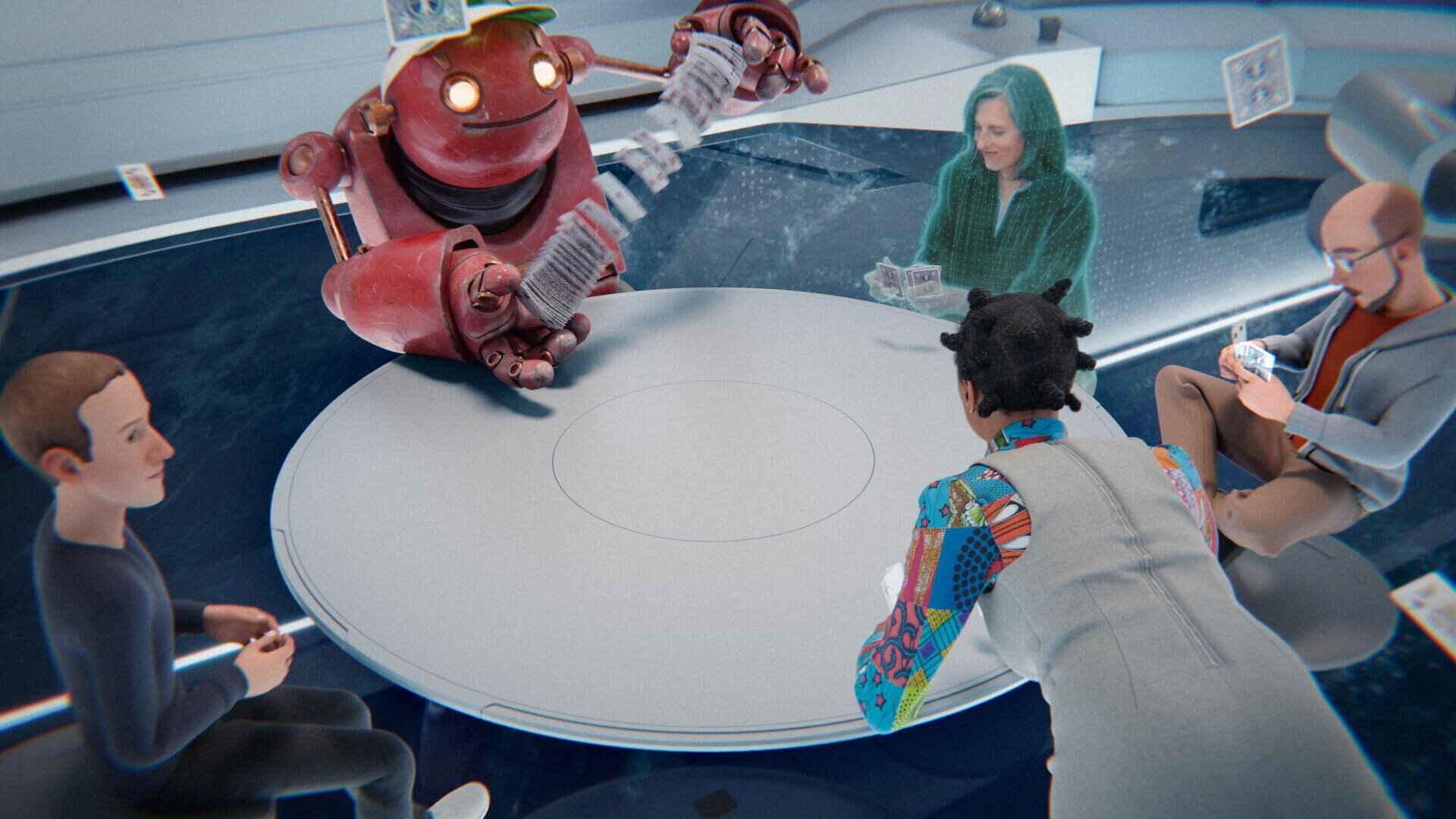Introduction
The concept of the Metaverse has captured the imagination of both the tech world and popular culture. It promises a virtual reality realm where people can interact, explore, and create within a limitless digital landscape. With the rising popularity of virtual reality and augmented reality technologies, the Metaverse holds the potential to revolutionize the way we live, work, and socialize.
The idea of the Metaverse was popularized by Neal Stephenson’s science fiction novel “Snow Crash” in 1992, envisioning a shared virtual reality space where users can engage in various activities. Since then, the concept has been fueled by advancements in computing power, internet connectivity, and the development of immersive technologies.
However, despite the initial hype and excitement surrounding the Metaverse, the reality has been somewhat different. While there have been notable advancements and successful applications of virtual reality and augmented reality, the full realization of a true, interconnected Metaverse has yet to be achieved.
In this article, we will explore the rise and fall of the Metaverse hype and the factors that have contributed to its decline. We will also examine the current state of the Metaverse and discuss the lessons learned from its journey thus far. By doing so, we aim to gain a better understanding of its potential future prospects and the challenges that need to be addressed to make the vision of the Metaverse a reality.
Definition of Metaverse
The term “Metaverse” refers to a virtual reality space where users can engage in immersive experiences and interact with one another in real-time. It is a collective virtual shared space that encompasses both physical and virtual environments. The concept goes beyond traditional virtual reality, as it aims to create a fully interconnected digital universe that is accessible to anyone with the necessary technology.
In the Metaverse, users can navigate through different digital worlds, interact with virtual objects and characters, and even create their own content. It is a place where the boundaries between the physical and digital worlds merge, allowing for endless possibilities and opportunities for collaboration, communication, and exploration.
The Metaverse is not confined to any specific platform or technology. It can be accessed through various devices, such as virtual reality headsets, augmented reality glasses, personal computers, and even mobile devices. The goal is to create a seamless and immersive experience for users, regardless of the medium through which they access the virtual world.
One of the key features of the Metaverse is its persistence. Unlike traditional video games or virtual reality experiences, the Metaverse is designed to be an ongoing, ever-evolving environment. It is a world that continues to exist and evolve even when users are not actively present. This persistence enables users to have continuous interactions and experiences within the Metaverse, whether they are engaged in real-time activities or not.
Overall, the Metaverse is a digital realm that aims to blur the line between the physical and virtual worlds. It is a place where users can escape the limitations of physical reality and immerse themselves in a fully interactive and interconnected digital universe. While the concept is still in its early stages, the potential impact of the Metaverse on various industries, including entertainment, education, and business, is vast and promising.
The Rise and Fall of Metaverse Hype
The Metaverse concept experienced a surge of hype and excitement over the past decade, driven by advancements in technology and the promise of a futuristic digital world. It captured the attention of both tech enthusiasts and mainstream media, sparking visions of a virtual utopia where people could escape reality and immerse themselves in a boundless digital realm.
During the peak of the Metaverse hype, major companies and investors heavily invested in virtual reality and augmented reality technologies. Startups emerged, developing innovative applications and platforms that aimed to bring the Metaverse to life. This influx of capital and attention created a sense of anticipation and high expectations for what the Metaverse could offer.
However, as time went on, the initial excitement surrounding the Metaverse began to wane. The grand visions and ambitious promises started to collide with the practical realities of building a fully functioning and interconnected digital universe. The Metaverse faced numerous challenges and setbacks that contributed to its decline in popularity and loss of hype.
One of the primary factors in the fall of Metaverse hype was the slow pace of technological advancements. While significant progress has been made in virtual reality and augmented reality technologies, many of the early promises of a fully immersive and interconnected Metaverse have not yet materialized. The development and adoption of the necessary hardware and software have fallen short of expectations, resulting in a limited user base and fragmented experiences.
Moreover, concerns around privacy and security have also played a role in dampening the enthusiasm for the Metaverse. As more personal information and data are being shared and stored in virtual environments, there is a growing concern about protecting user privacy and safeguarding against potential security breaches. These concerns have raised skepticism and diminished trust in the Metaverse as a safe and secure space for users.
Another factor contributing to the decline of the Metaverse hype is the lack of interoperability and standardization. Different virtual reality platforms and applications often operate in silos, lacking compatibility and seamless integration. This limits the potential for users to explore a truly interconnected Metaverse, as they are confined to specific platforms and unable to freely navigate between different virtual worlds.
Lastly, the overhyped expectations and unrealistic promises surrounding the Metaverse have also led to its downfall. As the hype grew, so did the pressure to deliver on the grand visions presented to the public. When the initial promises fell short, critics and skeptics emerged, scrutinizing the concept and questioning its feasibility. This resulted in a loss of credibility and trust in the potential of the Metaverse to revolutionize the way we interact and engage with digital spaces.
In summary, the rise and fall of Metaverse hype can be attributed to a combination of technological limitations, privacy and security concerns, lack of interoperability, and the failure to meet overinflated expectations. While the hype may have faded, it is important to learn from these challenges and pave the way for a more sustainable and realistic future for the Metaverse.
Factors Contributing to the Decline of Metaverse
The decline of the Metaverse can be attributed to several factors that have hindered its progress and dampened the initial enthusiasm surrounding the concept. Understanding these factors is crucial in order to address the challenges and pave the way for a more successful and sustainable future for the Metaverse.
One of the main factors contributing to the decline of the Metaverse is the lack of interoperability and standardization. The Metaverse relies on seamless integration and compatibility between different virtual reality platforms and applications. However, the current landscape is characterized by fragmentation, with each platform operating independently and lacking the ability to communicate and interact with others. This limits the potential for a fully interconnected Metaverse and hampers the ability of users to freely navigate between virtual worlds.
Privacy and security concerns also play a significant role in the decline of the Metaverse. As users immerse themselves in virtual environments and share personal information, there is a growing need to protect their privacy and ensure the security of their data. The potential for unauthorized access, data breaches, and unethical use of information raises skepticism and reduces the trust in the Metaverse as a safe and secure space. Addressing these concerns is crucial to rebuilding trust and fostering widespread adoption of the Metaverse.
Additionally, the overhyped expectations and unrealistic promises surrounding the Metaverse have contributed to its decline. The initial excitement and grand visions presented to the public set high expectations that have not been met. This has created a sense of disappointment and skepticism, as the reality of building a fully immersive and interconnected Metaverse proved to be more challenging than anticipated. Managing expectations and fostering realistic goals is essential in rebuilding confidence in the potential of the Metaverse.
The failure of major Metaverse projects has also played a role in the decline of the concept. Some high-profile initiatives, backed by significant investments, have struggled to deliver on their promises and have faced financial difficulties. This has not only impacted investor confidence but has also cast a shadow of doubt on the viability and feasibility of the Metaverse. Learning from these failures and adopting a more sustainable and realistic approach is crucial to rebuilding trust and fostering further development in the Metaverse space.
In summary, the decline of the Metaverse can be attributed to factors such as the lack of interoperability, privacy and security concerns, overhyped expectations, and the failure of major projects. Addressing these challenges and taking a more realistic and sustainable approach will be key in revitalizing the concept and realizing the full potential of the Metaverse.
Lack of Interoperability and Standardization
One of the significant factors contributing to the decline of the Metaverse is the lack of interoperability and standardization within the virtual reality industry. Interoperability refers to the ability of different platforms, applications, and devices to seamlessly communicate and interact with each other. Standardization involves the establishment of agreed-upon protocols, formats, and technical specifications that ensure compatibility and consistency across different virtual reality experiences.
Currently, the virtual reality landscape is characterized by fragmentation, with each platform and application operating independently. There is a lack of unified standards and protocols that enable users to freely navigate and interact within a fully interconnected Metaverse. Different virtual reality platforms have their own ecosystems, exclusive content, and proprietary technologies, creating silos that limit user experiences and collaboration.
The absence of interoperability not only hampers the potential for a seamless Metaverse experience but also limits user freedom and choice. Users are confined to specific platforms and cannot easily transfer their assets, avatars, or progress from one virtual world to another. This lack of mobility undermines the potential for a truly interconnected Metaverse where users can explore multiple virtual environments and engage with various communities.
The lack of standardization also poses challenges for developers and content creators. The absence of clear technical specifications and guidelines makes it difficult for them to develop applications and experiences that are compatible across multiple platforms. This increases development costs and hampers innovation, as developers must create separate versions of their products for different platforms, detracting from the overall user experience.
Furthermore, the lack of interoperability and standardization inhibits collaboration and cooperation within the virtual reality industry. Developers, researchers, and companies face barriers in sharing knowledge, resources, and expertise. This hinders the collective effort to advance the Metaverse and limits the potential for cross-platform experiences and shared user communities.
To address this challenge, the virtual reality industry needs to prioritize the development of interoperability standards and protocols. Establishing open standards that enable different platforms and applications to communicate and exchange data will foster collaboration, encourage innovation, and ensure a more cohesive and seamless user experience. These standards should encompass aspects such as data formats, communication protocols, and user identities, allowing for seamless transfer of assets and interactions between virtual worlds.
By fostering interoperability and standardization, the Metaverse can become a truly interconnected digital realm, where users can freely navigate, interact, and engage in a wide range of virtual experiences. It will unlock new opportunities for collaboration, creativity, and social interaction, creating a more immersive and fulfilling user experience. Collaborative efforts between industry stakeholders, such as VR/AR companies, developers, and standards organizations, are crucial in overcoming the challenges and realizing the full potential of a connected Metaverse.
Privacy and Security Concerns
One of the major factors contributing to the decline of the Metaverse is the growing concern over privacy and security. As virtual reality and augmented reality technologies become more advanced, users are increasingly sharing personal information and engaging in immersive experiences within digital environments. This raises important questions and challenges regarding the protection of user privacy and the security of their data.
In the Metaverse, users may share personal details, such as their name, age, location, and even biometric data. Additionally, they may engage in social interactions, create and share content, and make online purchases. This abundance of personal information creates vulnerabilities that can be exploited by malicious actors, leading to identity theft, fraud, and other cybercrimes.
Furthermore, the immersive nature of the Metaverse blurs the boundaries between the real and virtual worlds. Users may find it challenging to differentiate between genuine and virtual interactions, leading to potential manipulation or deception. The potential for social engineering, phishing attacks, and other tactics aimed at accessing personal information is a significant concern in the virtual reality space.
Another aspect of privacy and security concerns in the Metaverse is the collection and storage of user data. Virtual reality platforms and applications may gather a wealth of information about users’ behaviors, preferences, and interactions. This data can be used for targeted advertising, behavior analysis, and potentially even sold to third parties without users’ explicit consent. This lack of transparency and control over personal data raises serious privacy concerns.
To address these challenges, stakeholders in the virtual reality industry must prioritize privacy and security measures. This includes implementing strong encryption protocols, robust authentication mechanisms, and secure data storage practices. Companies should also provide transparent privacy policies and obtain explicit user consent for data collection and usage.
Additionally, industry standards and best practices should be established to ensure a consistent level of privacy and security across different virtual reality platforms. Collaborative efforts between VR/AR companies, regulators, and privacy advocates are vital to developing comprehensive guidelines and regulations that protect user privacy while fostering innovation in the Metaverse.
Educating users about privacy and security best practices is also crucial. Users should be aware of the risks and take necessary precautions, such as using strong passwords, being cautious about sharing personal information, and staying vigilant against potential scams or phishing attempts. User empowerment and informed decision-making are essential in safeguarding their privacy and security in the Metaverse.
In summary, privacy and security concerns pose significant challenges to the widespread adoption and success of the Metaverse. Strengthening security measures, establishing industry standards, and empowering users to protect their privacy are essential steps in overcoming these challenges. By addressing these concerns, the Metaverse can become a safer and more trusted digital space that encourages users to engage, explore, and create within its immersive virtual realms.
Overhyped Expectations and Unrealistic Promises
The decline of the Metaverse can be partially attributed to the overhyped expectations and unrealistic promises that were made during its rise in popularity. As the concept gained traction and captured the imagination of both the tech industry and the general public, extravagant claims were made about the capabilities and potential impact of the virtual reality space.
During the peak of Metaverse hype, there were unrealistic promises of a fully immersive and interconnected digital world that would revolutionize various aspects of our lives. It was said that the Metaverse would transform entertainment, education, social interactions, and even business transactions. These grand visions created excitement and anticipation, fueling expectations that were difficult to meet in practice.
However, as the Metaverse began to materialize, it became apparent that building a fully functioning and interconnected digital universe was far more complex and challenging than initially anticipated. Technological limitations, such as the lack of high-quality virtual reality hardware and limited computing power, presented barriers that hindered the seamless realization of the Metaverse’s potential.
Moreover, the hype around the Metaverse led to unrealistic expectations regarding the timeline for its development. The concept garnered attention and investment, leading many to believe that a fully realized Metaverse would be available in a short span of time. However, the reality is that the development of complex and immersive virtual reality technologies takes time, resources, and iterative improvements.
Another aspect contributing to the decline of the Metaverse hype is the disconnect between the initial promises and the actual user experiences. Early demonstrations and promotional material painted an idealized vision of the Metaverse, presenting it as an incredibly realistic and immersive digital realm. However, when users finally had the chance to engage with virtual reality technologies and experiences, they often fell short of the hyperbolic expectations set by the hype.
This gap between expectation and reality has led to a sense of disappointment and skepticism among users, tarnishing the perception of the Metaverse. Some view it as a failed promise rather than an evolving and ongoing technological endeavor. By overpromising and underdelivering, the Metaverse struggled to meet the lofty expectations set during the peak of its hype.
Moving forward, it is important to manage expectations and take a more realistic approach to the development of the Metaverse. Acknowledging the challenges, limitations, and the iterative nature of technological advancements will help align expectations with the current state of virtual reality technologies. By doing so, the industry can build trust, foster genuine excitement based on real progress, and work towards the gradual realization of the Metaverse’s full potential.
Failure of Major Metaverse Projects
The decline of the Metaverse can be attributed, in part, to the failure of major projects that set out to bring the concept to life. Despite significant investments and ambitious goals, these high-profile initiatives struggled to deliver on their promises, resulting in setbacks and diminishing confidence in the viability of the Metaverse.
One of the primary reasons for the failure of major Metaverse projects is the immense technical challenges involved. Building a fully functioning and interconnected digital universe requires advanced virtual reality technologies, powerful computing infrastructure, and complex software systems. Many projects underestimated the sheer complexity and scale of developing a Metaverse, leading to delays, technical issues, and quality concerns in their products.
Additionally, the business models adopted by some major Metaverse projects were not sustainable or profitable. Some initiatives relied heavily on investor funding or revenue from virtual asset sales, without establishing clear monetization strategies or long-term sustainability plans. As a result, these projects faced financial difficulties and struggled to generate the necessary revenue to support ongoing development and operation.
Another factor contributing to the failure of major Metaverse projects is the lack of user adoption. Despite the hype and excitement surrounding the concept, reaching critical mass in terms of user base proved challenging. This can be attributed to various factors, including the high cost of virtual reality hardware, limited accessibility, concerns over privacy and security, and limited content availability. Without a significant user base, these projects struggled to attract and retain users, ultimately leading to their demise.
Moreover, some major Metaverse projects faced issues regarding community management and governance. The decentralized nature of the Metaverse requires robust systems for content moderation, user safety, and dispute resolution. Without effective governance mechanisms in place, projects encountered challenges in addressing issues such as harassment, copyright infringement, and fraudulent activities. These governance failures undermined user trust and hindered the growth and sustainability of the platforms.
The failure of major Metaverse projects serves as a valuable lesson for the industry. It highlights the importance of realistic planning, technical feasibility assessment, sustainable business models, and effective community management. By learning from these failures, future Metaverse initiatives can navigate the challenges more effectively and build a strong foundation for success.
It is worth noting that the failure of these projects does not imply the failure of the overall concept of the Metaverse. Rather, it emphasizes the need for a more measured and incremental approach to its development. As the industry moves forward, it is crucial to foster collaboration, share best practices, and work towards building a sustainable and interconnected Metaverse that can truly transform the way we interact, create, and experience digital worlds.
Current State of Metaverse
The Metaverse has evolved significantly since its initial conception, but its development is still a work in progress. As of the present day, the Metaverse is characterized by a diverse range of virtual reality experiences, immersive technologies, and interconnected digital environments. While the Metaverse is not yet fully realized, progress has been made in several key areas.
Virtual reality hardware has become increasingly accessible and advanced, with a variety of headsets available to consumers. These devices offer more realistic and immersive experiences, allowing users to physically interact with virtual environments and objects. Improved ergonomics, increased display resolutions, and enhanced tracking technologies have contributed to the overall improvement of the VR experience.
Content creation platforms and tools have also evolved, enabling individuals and developers to create and share virtual experiences. User-generated content has enriched the Metaverse, allowing for diverse and engaging virtual environments created by the community. This encourages exploration, creativity, and collaboration within the virtual space.
Social interaction and communication within the Metaverse have seen advancements as well. Virtual reality platforms offer multiplayer experiences, enabling users to engage with others in real-time, participate in shared activities, and even attend virtual events. Virtual reality social platforms foster connections and communities, allowing users to interact and socialize with like-minded individuals from around the world.
However, challenges persist in realizing the full vision of a truly interconnected and seamless Metaverse. The lack of interoperability and standardization continues to limit the ability to navigate and interact between different virtual reality platforms and experiences. Fragmentation remains an obstacle, preventing users from freely exploring interconnected virtual worlds and hindering collaboration between developers and content creators.
Privacy and security concerns also persist in the current state of the Metaverse. Despite efforts to address these issues, there is still a need for robust mechanisms that protect user data, ensure privacy, and build trust in virtual reality experiences. Striking the right balance between providing immersive and personalized experiences while respecting user privacy will be critical for the continued growth of the Metaverse.
Looking ahead, there is immense potential for the Metaverse to further evolve and mature. Continued advancements in technology, increased collaboration, and industry-wide efforts to address challenges will contribute to the growth of the Metaverse. As virtual reality becomes more mainstream and accessible, we can expect the Metaverse to become an increasingly integral part of our digital lives, transforming various industries and shaping the future of interactive experiences.
Lessons Learned and Future Prospects
The development and evolution of the Metaverse have provided valuable lessons that can guide future endeavors and shape the prospects of this concept. Reflecting on these lessons can help lay the foundation for a more successful and sustainable future for the Metaverse.
One of the key lessons learned is the importance of managing expectations. Overhyping the capabilities and potential of the Metaverse can lead to unrealistic expectations and disappointment when those expectations are not met. It is crucial to foster a realistic understanding of the challenges and limitations involved in building a fully functioning and interconnected digital universe. By setting realistic expectations, we can focus on making steady progress and achieving tangible milestones.
Interoperability and standardization are vital for the success of the Metaverse. The lack of compatibility between different virtual reality platforms and experiences hampers the seamless navigation and interaction within the digital realm. Establishing industry-wide standards and protocols for interoperability will enable users to freely explore and engage with a variety of virtual worlds, fostering collaboration and enhancing the overall user experience.
Privacy and security should be at the forefront of Metaverse development. Learning from past experiences, developers must prioritize the protection of user data and ensure robust security measures are in place. By promoting transparency, implementing privacy-enhancing technologies, and empowering users with control over their personal information, trust can be built and privacy concerns can be addressed more effectively.
Collaboration and open ecosystems are crucial for fostering innovation and growth in the Metaverse. Developers, content creators, researchers, and industry stakeholders should come together to share knowledge, exchange ideas, and collaborate on advancing the Metaverse. Embracing open-source approaches and encouraging the development of interoperable tools and platforms will promote creativity, diversity, and inclusivity within the Metaverse.
Furthermore, integrating ethical considerations into Metaverse development is of utmost importance. Balancing the potential for immersive experiences and new virtual realities with the need to ensure user well-being, safety, and inclusivity is critical. Designing and implementing mechanisms that prevent harassment, safeguard against discrimination, and promote positive user experiences will help create a vibrant and welcoming Metaverse for all.
Looking to the future, the prospects of the Metaverse are promising. As technology continues to advance, virtual reality becomes more accessible, and industry collaboration strengthens, the Metaverse is poised to transform the way we live, work, and play. We can expect a more interconnected, immersive, and dynamic digital realm that opens up endless possibilities for entertainment, education, communication, and beyond.
While there are still challenges to overcome, the lessons learned from the development of the Metaverse provide the roadmap for a more pragmatic and successful approach. By addressing these lessons, working collaboratively, and staying committed to user-centric design and privacy, the Metaverse will continue to evolve and shape the future of human interaction with digital environments.
Conclusion
The Metaverse, a concept that once sparked tremendous excitement and hype, has faced numerous challenges on its path to becoming a fully realized digital realm. The initial grand visions and ambitious promises surrounding the Metaverse collided with the practical realities of technological limitations, privacy concerns, interoperability issues, and failed projects. However, from these setbacks, valuable lessons have been learned that can guide the future development of the Metaverse.
It is clear that managing expectations and fostering a realistic understanding of the challenges involved is crucial. The journey to create a fully interconnected and immersive digital universe requires time, collaboration, and iterative improvements. Interoperability and standardization are vital for the seamless navigation and interaction within the Metaverse, ensuring users can freely explore diverse virtual worlds. Privacy and security concerns must be addressed to protect user data and build trust in virtual reality experiences.
Collaboration, open ecosystems, and ethical considerations are essential for driving innovation and creating a welcoming and inclusive Metaverse. By sharing knowledge, exchanging ideas, and promoting diversity, the Metaverse can become a vibrant and dynamic space that caters to the evolving needs and interests of users.
Looking to the future, the prospects of the Metaverse are promising. With advancements in technology, increased accessibility, and ongoing collaboration, the Metaverse holds great potential to transform various industries and revolutionize the way we interact with digital environments.
However, it is important to remember that the development of the Metaverse is an ongoing journey, with challenges, setbacks, and opportunities for growth. By learning from past experiences, fostering realistic expectations, prioritizing user privacy and security, promoting interoperability, and embracing collaboration and inclusivity, the Metaverse can continue to evolve and shape the future of digital experiences.
In conclusion, the Metaverse represents a visionary concept that has captured the imagination of many. Although the road ahead may be challenging, by embracing the lessons learned and working towards a more realistic, inclusive, and secure Metaverse, we can build a future where immersive digital experiences enhance our lives and unlock endless possibilities in the virtual realm.

























